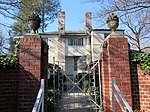1921 U.S. Open (golf)
The 1921 U.S. Open was the 25th U.S. Open, held July 21–22 at Columbia Country Club in Chevy Chase, Maryland, a suburb northwest of Washington, D.C. Jim Barnes won his only U.S. Open, nine strokes ahead of runners-up Walter Hagen and Fred McLeod, both former champions. It was the third of Barnes' four major championships. Barnes shot an opening round 69 on Thursday morning and led wire-to-wire; he led McLeod by four after the second round, and by seven through 54 holes. President Warren G. Harding was in attendance for the final round on Friday afternoon and presented the championship cup and medal to Barnes. Barnes' play was described by Evening Star sports reporter Walter R. McCallum as "a remarkable brand of golf by playing with the most implicit confidence and coolness".Chick Evans, the 1916 champion, edged 19-year-old Bobby Jones by a single stroke for low amateur, finishing alone in fourth place. Two-time champion Alex Smith played in his last major and finished in a tie for fifth place.
Excerpt from the Wikipedia article 1921 U.S. Open (golf) (License: CC BY-SA 3.0, Authors).1921 U.S. Open (golf)
East-West Highway,
Geographical coordinates (GPS) Address Nearby Places Show on map
Geographical coordinates (GPS)
| Latitude | Longitude |
|---|---|
| N 38.989 ° | E -77.079 ° |
Address
East-West Highway (East West Highway)
East-West Highway
20815
Maryland, United States
Open on Google Maps





